EARLY CHILDHOOD EDUCATION AND CARE QUESTION ANSWER 2022
VerifiedAdded on 2022/09/28
|15
|2753
|26
AI Summary
Contribute Materials
Your contribution can guide someone’s learning journey. Share your
documents today.
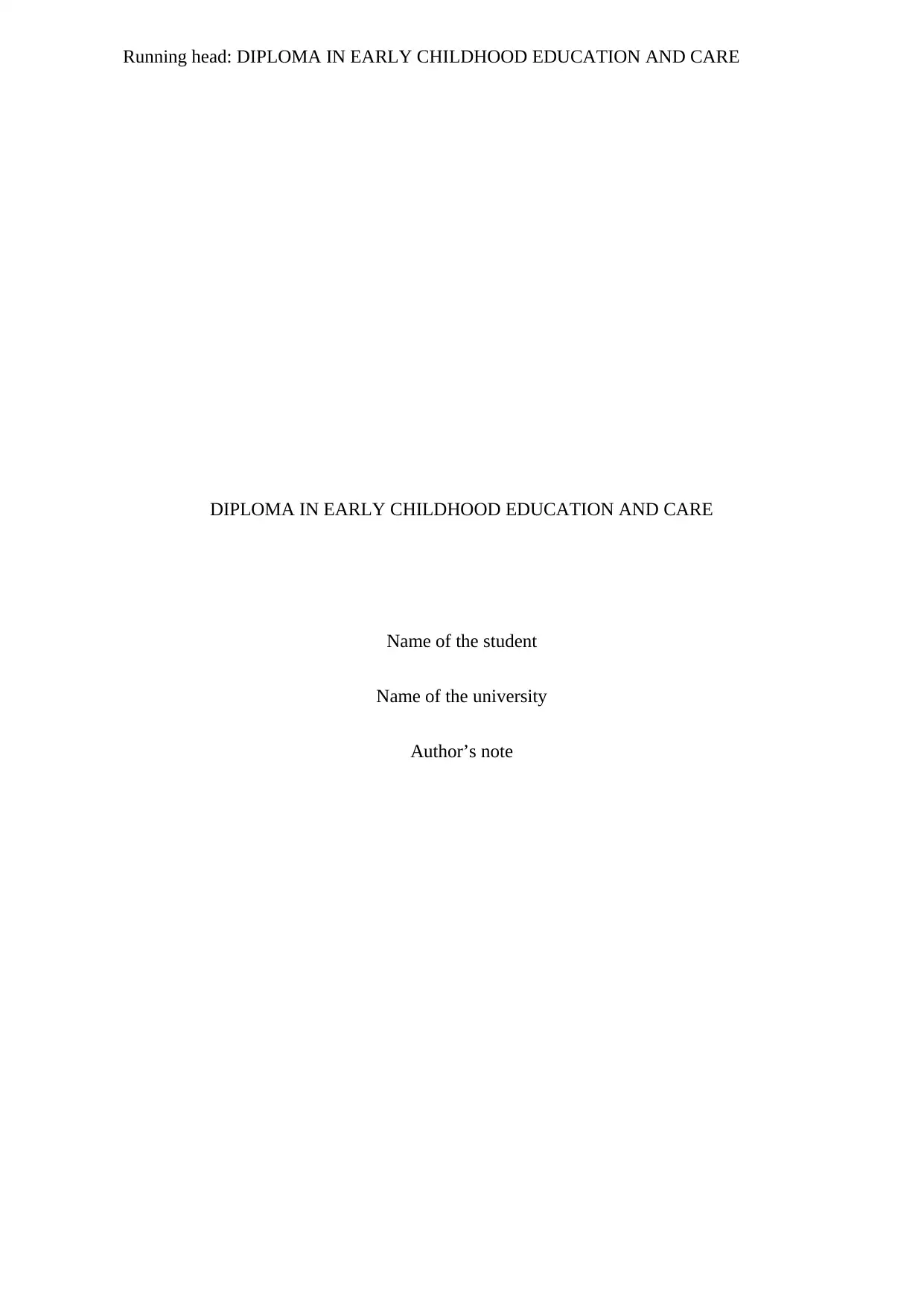
Running head: DIPLOMA IN EARLY CHILDHOOD EDUCATION AND CARE
DIPLOMA IN EARLY CHILDHOOD EDUCATION AND CARE
Name of the student
Name of the university
Author’s note
DIPLOMA IN EARLY CHILDHOOD EDUCATION AND CARE
Name of the student
Name of the university
Author’s note
Secure Best Marks with AI Grader
Need help grading? Try our AI Grader for instant feedback on your assignments.
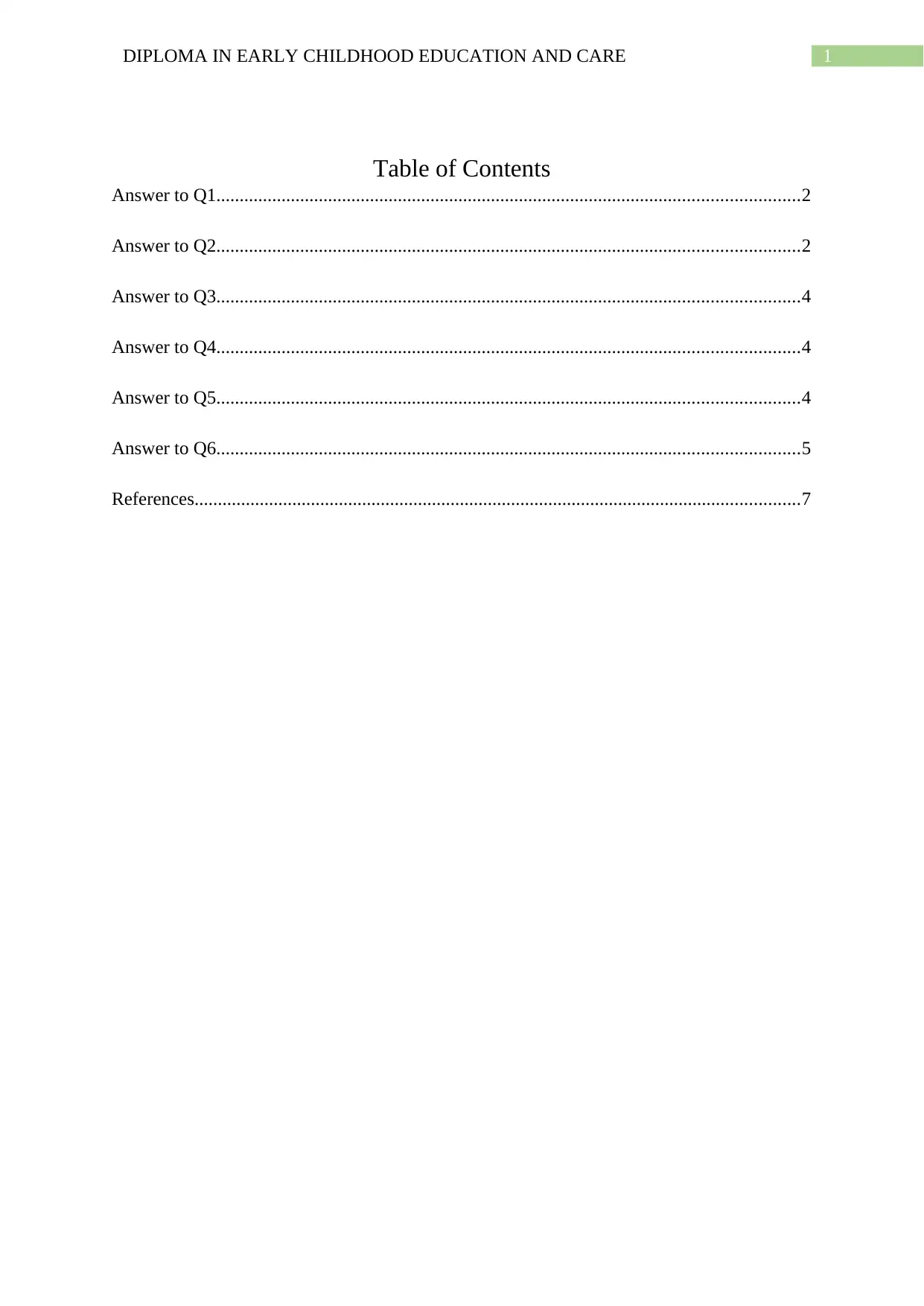
1DIPLOMA IN EARLY CHILDHOOD EDUCATION AND CARE
Table of Contents
Answer to Q1.............................................................................................................................2
Answer to Q2.............................................................................................................................2
Answer to Q3.............................................................................................................................4
Answer to Q4.............................................................................................................................4
Answer to Q5.............................................................................................................................4
Answer to Q6.............................................................................................................................5
References..................................................................................................................................7
Table of Contents
Answer to Q1.............................................................................................................................2
Answer to Q2.............................................................................................................................2
Answer to Q3.............................................................................................................................4
Answer to Q4.............................................................................................................................4
Answer to Q5.............................................................................................................................4
Answer to Q6.............................................................................................................................5
References..................................................................................................................................7
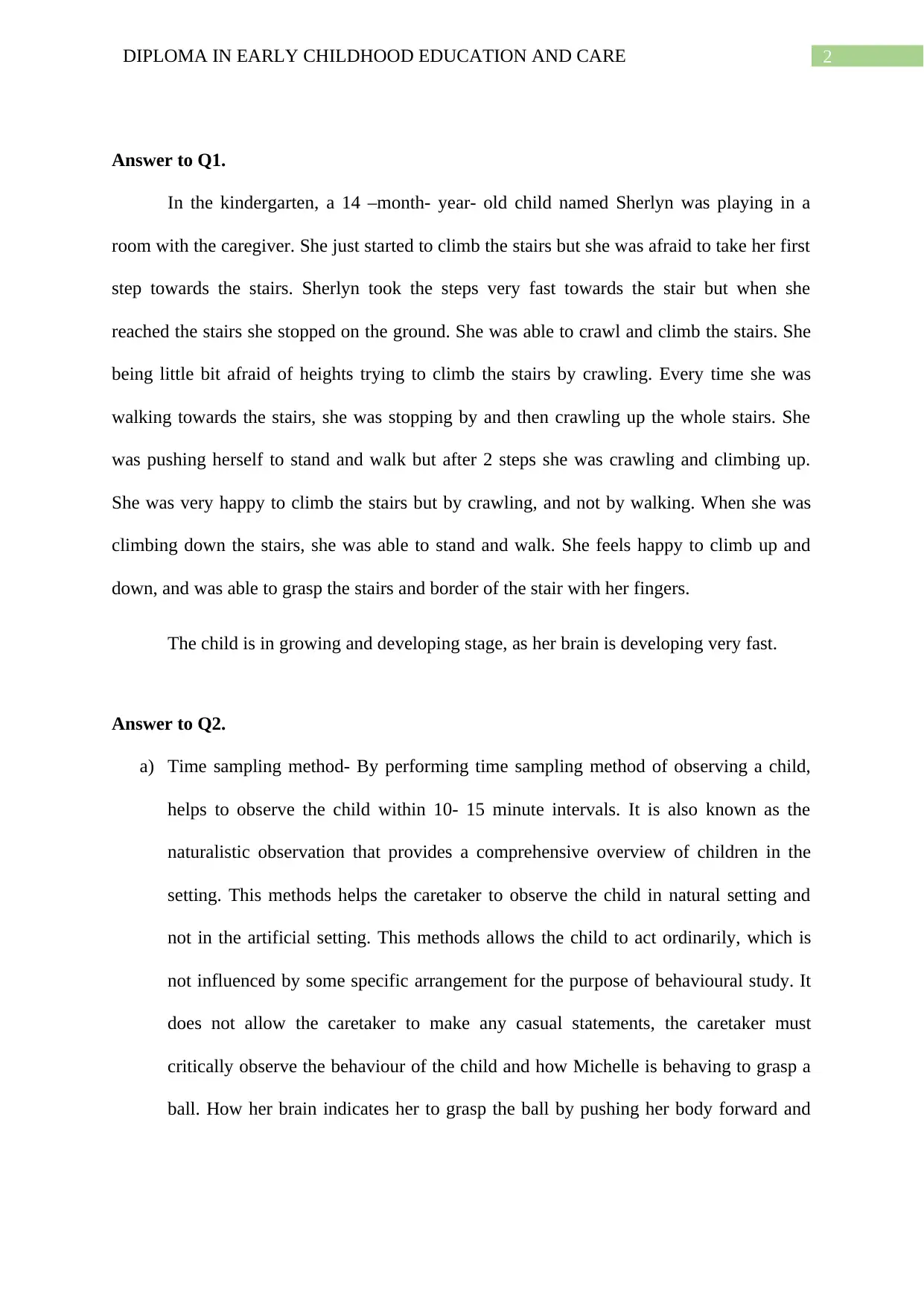
2DIPLOMA IN EARLY CHILDHOOD EDUCATION AND CARE
Answer to Q1.
In the kindergarten, a 14 –month- year- old child named Sherlyn was playing in a
room with the caregiver. She just started to climb the stairs but she was afraid to take her first
step towards the stairs. Sherlyn took the steps very fast towards the stair but when she
reached the stairs she stopped on the ground. She was able to crawl and climb the stairs. She
being little bit afraid of heights trying to climb the stairs by crawling. Every time she was
walking towards the stairs, she was stopping by and then crawling up the whole stairs. She
was pushing herself to stand and walk but after 2 steps she was crawling and climbing up.
She was very happy to climb the stairs but by crawling, and not by walking. When she was
climbing down the stairs, she was able to stand and walk. She feels happy to climb up and
down, and was able to grasp the stairs and border of the stair with her fingers.
The child is in growing and developing stage, as her brain is developing very fast.
Answer to Q2.
a) Time sampling method- By performing time sampling method of observing a child,
helps to observe the child within 10- 15 minute intervals. It is also known as the
naturalistic observation that provides a comprehensive overview of children in the
setting. This methods helps the caretaker to observe the child in natural setting and
not in the artificial setting. This methods allows the child to act ordinarily, which is
not influenced by some specific arrangement for the purpose of behavioural study. It
does not allow the caretaker to make any casual statements, the caretaker must
critically observe the behaviour of the child and how Michelle is behaving to grasp a
ball. How her brain indicates her to grasp the ball by pushing her body forward and
Answer to Q1.
In the kindergarten, a 14 –month- year- old child named Sherlyn was playing in a
room with the caregiver. She just started to climb the stairs but she was afraid to take her first
step towards the stairs. Sherlyn took the steps very fast towards the stair but when she
reached the stairs she stopped on the ground. She was able to crawl and climb the stairs. She
being little bit afraid of heights trying to climb the stairs by crawling. Every time she was
walking towards the stairs, she was stopping by and then crawling up the whole stairs. She
was pushing herself to stand and walk but after 2 steps she was crawling and climbing up.
She was very happy to climb the stairs but by crawling, and not by walking. When she was
climbing down the stairs, she was able to stand and walk. She feels happy to climb up and
down, and was able to grasp the stairs and border of the stair with her fingers.
The child is in growing and developing stage, as her brain is developing very fast.
Answer to Q2.
a) Time sampling method- By performing time sampling method of observing a child,
helps to observe the child within 10- 15 minute intervals. It is also known as the
naturalistic observation that provides a comprehensive overview of children in the
setting. This methods helps the caretaker to observe the child in natural setting and
not in the artificial setting. This methods allows the child to act ordinarily, which is
not influenced by some specific arrangement for the purpose of behavioural study. It
does not allow the caretaker to make any casual statements, the caretaker must
critically observe the behaviour of the child and how Michelle is behaving to grasp a
ball. How her brain indicates her to grasp the ball by pushing her body forward and
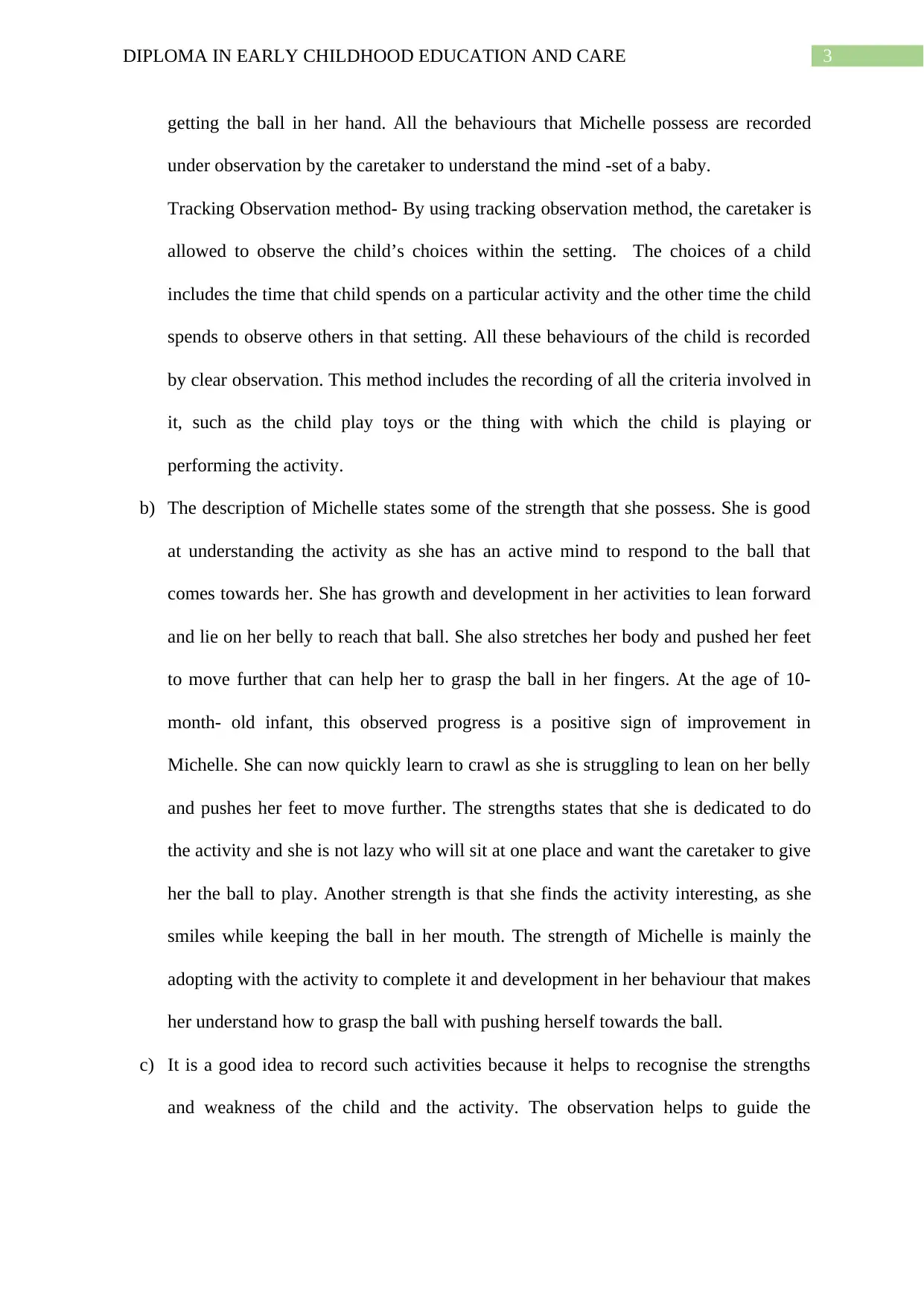
3DIPLOMA IN EARLY CHILDHOOD EDUCATION AND CARE
getting the ball in her hand. All the behaviours that Michelle possess are recorded
under observation by the caretaker to understand the mind -set of a baby.
Tracking Observation method- By using tracking observation method, the caretaker is
allowed to observe the child’s choices within the setting. The choices of a child
includes the time that child spends on a particular activity and the other time the child
spends to observe others in that setting. All these behaviours of the child is recorded
by clear observation. This method includes the recording of all the criteria involved in
it, such as the child play toys or the thing with which the child is playing or
performing the activity.
b) The description of Michelle states some of the strength that she possess. She is good
at understanding the activity as she has an active mind to respond to the ball that
comes towards her. She has growth and development in her activities to lean forward
and lie on her belly to reach that ball. She also stretches her body and pushed her feet
to move further that can help her to grasp the ball in her fingers. At the age of 10-
month- old infant, this observed progress is a positive sign of improvement in
Michelle. She can now quickly learn to crawl as she is struggling to lean on her belly
and pushes her feet to move further. The strengths states that she is dedicated to do
the activity and she is not lazy who will sit at one place and want the caretaker to give
her the ball to play. Another strength is that she finds the activity interesting, as she
smiles while keeping the ball in her mouth. The strength of Michelle is mainly the
adopting with the activity to complete it and development in her behaviour that makes
her understand how to grasp the ball with pushing herself towards the ball.
c) It is a good idea to record such activities because it helps to recognise the strengths
and weakness of the child and the activity. The observation helps to guide the
getting the ball in her hand. All the behaviours that Michelle possess are recorded
under observation by the caretaker to understand the mind -set of a baby.
Tracking Observation method- By using tracking observation method, the caretaker is
allowed to observe the child’s choices within the setting. The choices of a child
includes the time that child spends on a particular activity and the other time the child
spends to observe others in that setting. All these behaviours of the child is recorded
by clear observation. This method includes the recording of all the criteria involved in
it, such as the child play toys or the thing with which the child is playing or
performing the activity.
b) The description of Michelle states some of the strength that she possess. She is good
at understanding the activity as she has an active mind to respond to the ball that
comes towards her. She has growth and development in her activities to lean forward
and lie on her belly to reach that ball. She also stretches her body and pushed her feet
to move further that can help her to grasp the ball in her fingers. At the age of 10-
month- old infant, this observed progress is a positive sign of improvement in
Michelle. She can now quickly learn to crawl as she is struggling to lean on her belly
and pushes her feet to move further. The strengths states that she is dedicated to do
the activity and she is not lazy who will sit at one place and want the caretaker to give
her the ball to play. Another strength is that she finds the activity interesting, as she
smiles while keeping the ball in her mouth. The strength of Michelle is mainly the
adopting with the activity to complete it and development in her behaviour that makes
her understand how to grasp the ball with pushing herself towards the ball.
c) It is a good idea to record such activities because it helps to recognise the strengths
and weakness of the child and the activity. The observation helps to guide the
Secure Best Marks with AI Grader
Need help grading? Try our AI Grader for instant feedback on your assignments.
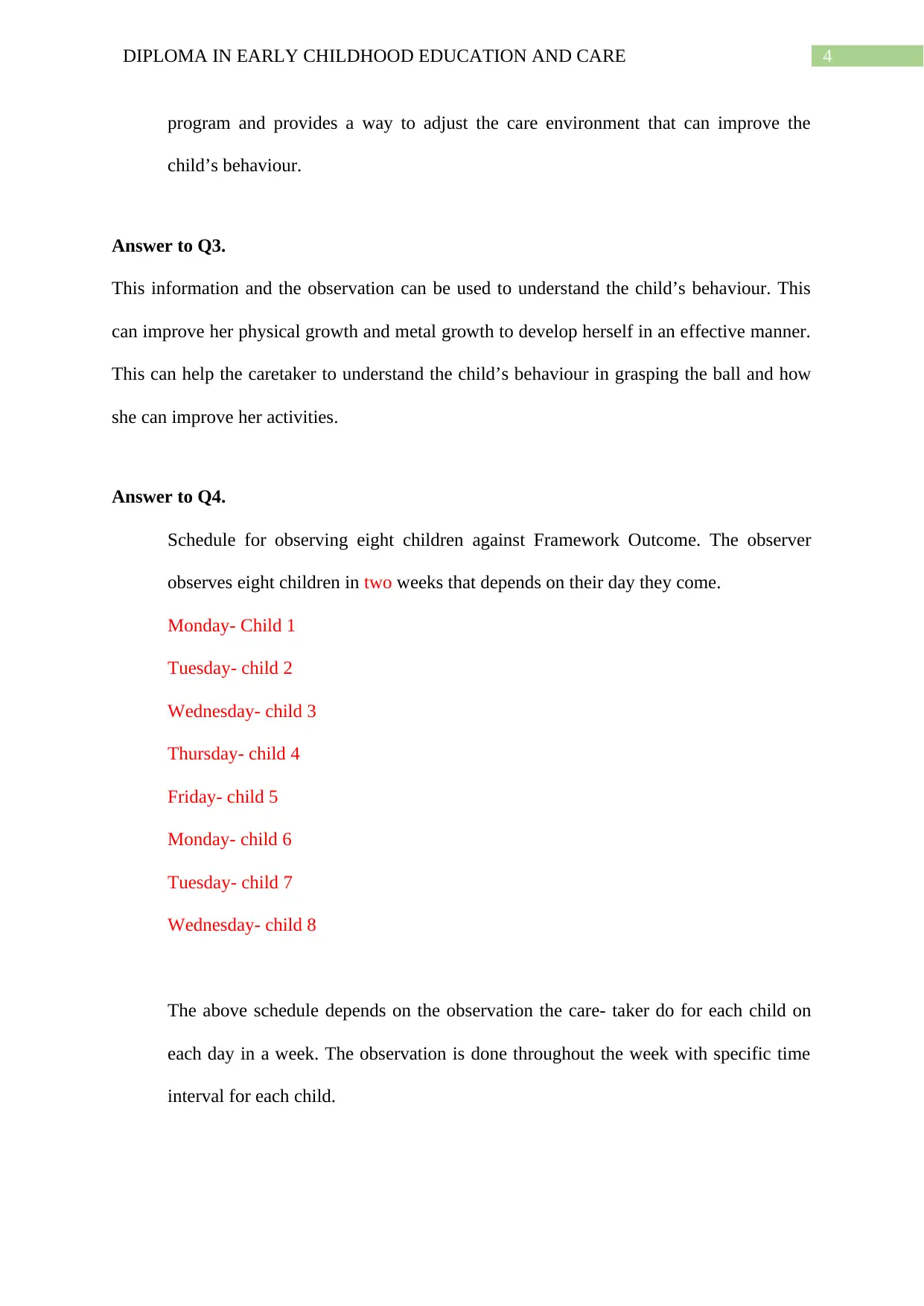
4DIPLOMA IN EARLY CHILDHOOD EDUCATION AND CARE
program and provides a way to adjust the care environment that can improve the
child’s behaviour.
Answer to Q3.
This information and the observation can be used to understand the child’s behaviour. This
can improve her physical growth and metal growth to develop herself in an effective manner.
This can help the caretaker to understand the child’s behaviour in grasping the ball and how
she can improve her activities.
Answer to Q4.
Schedule for observing eight children against Framework Outcome. The observer
observes eight children in two weeks that depends on their day they come.
Monday- Child 1
Tuesday- child 2
Wednesday- child 3
Thursday- child 4
Friday- child 5
Monday- child 6
Tuesday- child 7
Wednesday- child 8
The above schedule depends on the observation the care- taker do for each child on
each day in a week. The observation is done throughout the week with specific time
interval for each child.
program and provides a way to adjust the care environment that can improve the
child’s behaviour.
Answer to Q3.
This information and the observation can be used to understand the child’s behaviour. This
can improve her physical growth and metal growth to develop herself in an effective manner.
This can help the caretaker to understand the child’s behaviour in grasping the ball and how
she can improve her activities.
Answer to Q4.
Schedule for observing eight children against Framework Outcome. The observer
observes eight children in two weeks that depends on their day they come.
Monday- Child 1
Tuesday- child 2
Wednesday- child 3
Thursday- child 4
Friday- child 5
Monday- child 6
Tuesday- child 7
Wednesday- child 8
The above schedule depends on the observation the care- taker do for each child on
each day in a week. The observation is done throughout the week with specific time
interval for each child.
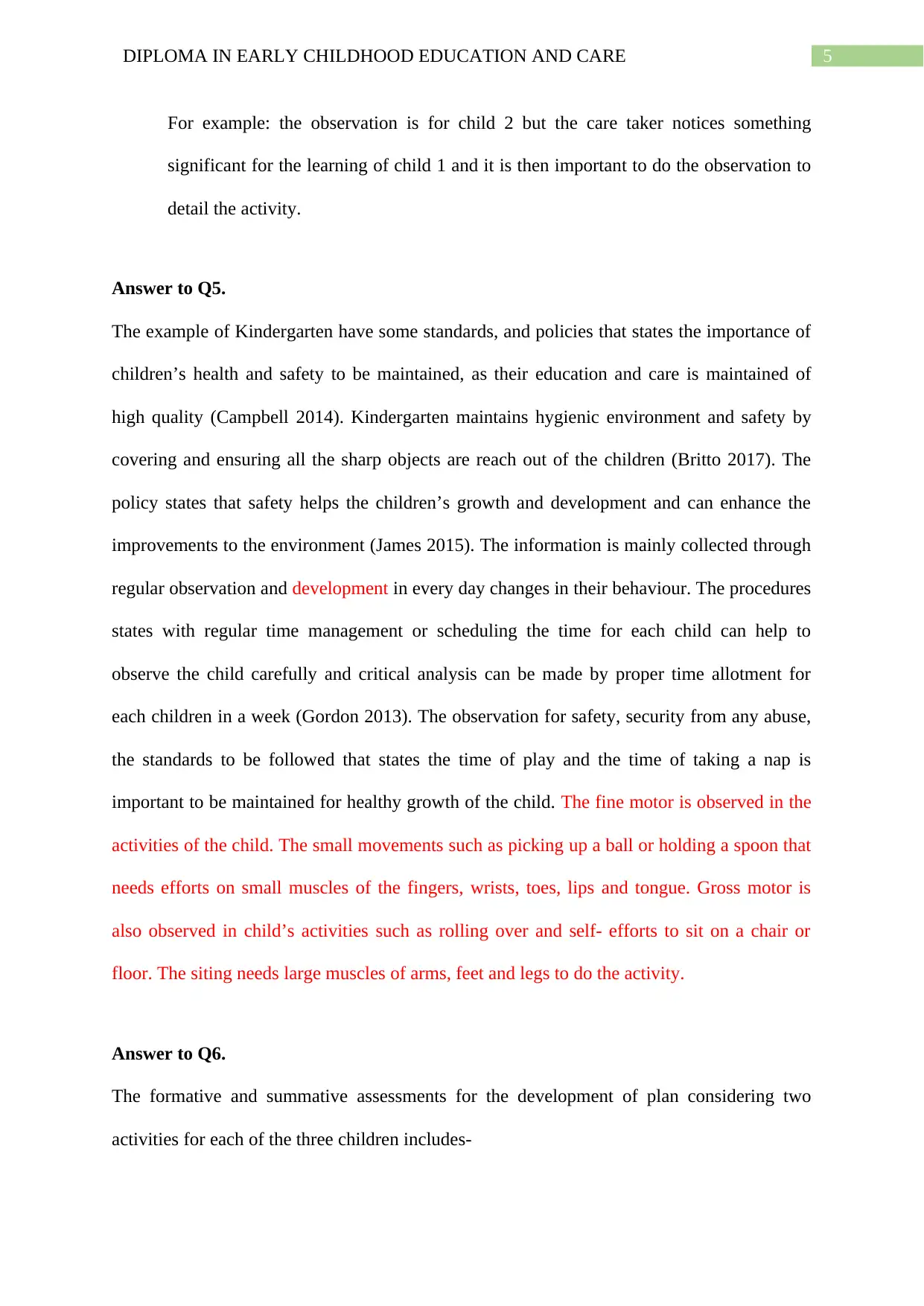
5DIPLOMA IN EARLY CHILDHOOD EDUCATION AND CARE
For example: the observation is for child 2 but the care taker notices something
significant for the learning of child 1 and it is then important to do the observation to
detail the activity.
Answer to Q5.
The example of Kindergarten have some standards, and policies that states the importance of
children’s health and safety to be maintained, as their education and care is maintained of
high quality (Campbell 2014). Kindergarten maintains hygienic environment and safety by
covering and ensuring all the sharp objects are reach out of the children (Britto 2017). The
policy states that safety helps the children’s growth and development and can enhance the
improvements to the environment (James 2015). The information is mainly collected through
regular observation and development in every day changes in their behaviour. The procedures
states with regular time management or scheduling the time for each child can help to
observe the child carefully and critical analysis can be made by proper time allotment for
each children in a week (Gordon 2013). The observation for safety, security from any abuse,
the standards to be followed that states the time of play and the time of taking a nap is
important to be maintained for healthy growth of the child. The fine motor is observed in the
activities of the child. The small movements such as picking up a ball or holding a spoon that
needs efforts on small muscles of the fingers, wrists, toes, lips and tongue. Gross motor is
also observed in child’s activities such as rolling over and self- efforts to sit on a chair or
floor. The siting needs large muscles of arms, feet and legs to do the activity.
Answer to Q6.
The formative and summative assessments for the development of plan considering two
activities for each of the three children includes-
For example: the observation is for child 2 but the care taker notices something
significant for the learning of child 1 and it is then important to do the observation to
detail the activity.
Answer to Q5.
The example of Kindergarten have some standards, and policies that states the importance of
children’s health and safety to be maintained, as their education and care is maintained of
high quality (Campbell 2014). Kindergarten maintains hygienic environment and safety by
covering and ensuring all the sharp objects are reach out of the children (Britto 2017). The
policy states that safety helps the children’s growth and development and can enhance the
improvements to the environment (James 2015). The information is mainly collected through
regular observation and development in every day changes in their behaviour. The procedures
states with regular time management or scheduling the time for each child can help to
observe the child carefully and critical analysis can be made by proper time allotment for
each children in a week (Gordon 2013). The observation for safety, security from any abuse,
the standards to be followed that states the time of play and the time of taking a nap is
important to be maintained for healthy growth of the child. The fine motor is observed in the
activities of the child. The small movements such as picking up a ball or holding a spoon that
needs efforts on small muscles of the fingers, wrists, toes, lips and tongue. Gross motor is
also observed in child’s activities such as rolling over and self- efforts to sit on a chair or
floor. The siting needs large muscles of arms, feet and legs to do the activity.
Answer to Q6.
The formative and summative assessments for the development of plan considering two
activities for each of the three children includes-
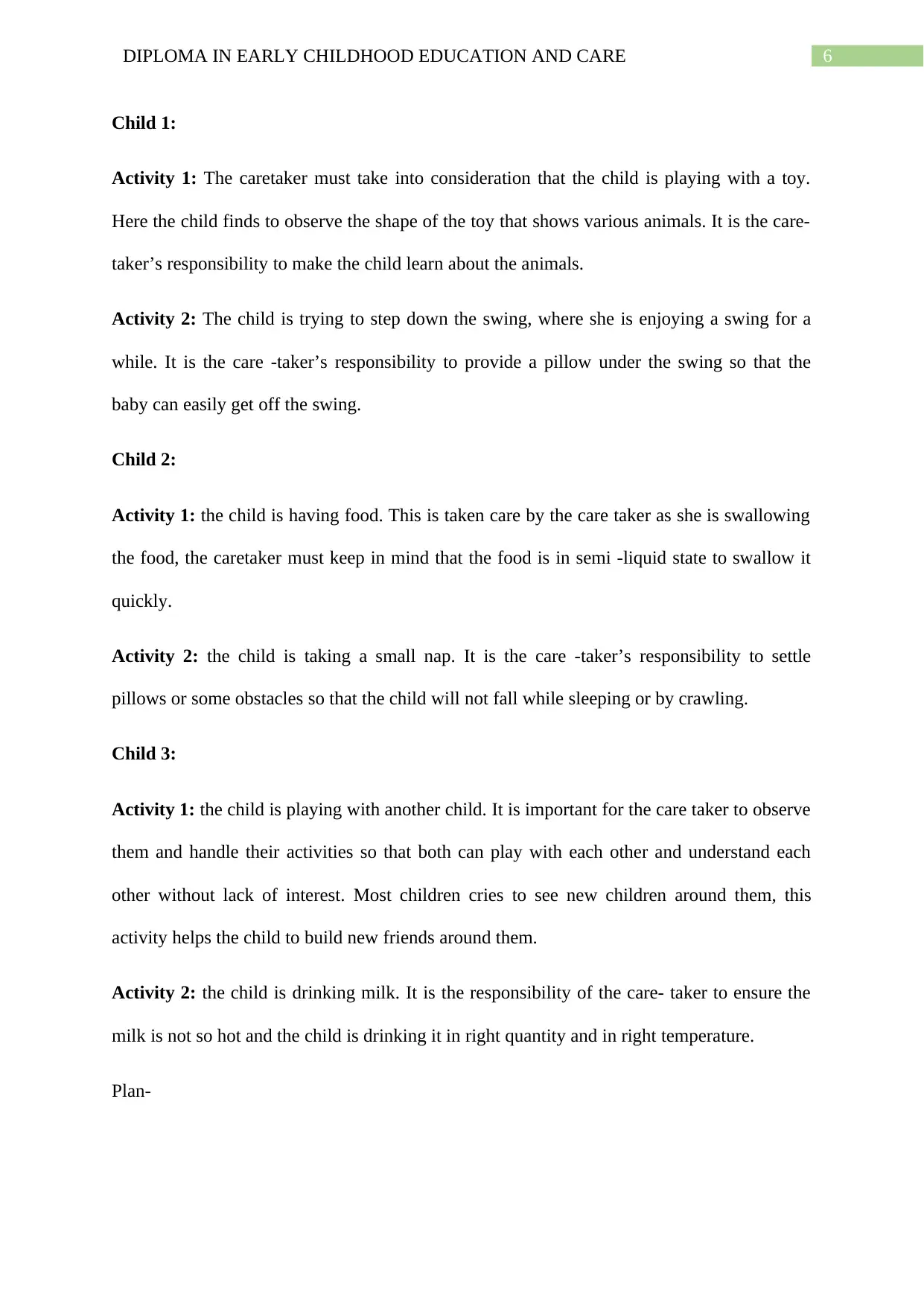
6DIPLOMA IN EARLY CHILDHOOD EDUCATION AND CARE
Child 1:
Activity 1: The caretaker must take into consideration that the child is playing with a toy.
Here the child finds to observe the shape of the toy that shows various animals. It is the care-
taker’s responsibility to make the child learn about the animals.
Activity 2: The child is trying to step down the swing, where she is enjoying a swing for a
while. It is the care -taker’s responsibility to provide a pillow under the swing so that the
baby can easily get off the swing.
Child 2:
Activity 1: the child is having food. This is taken care by the care taker as she is swallowing
the food, the caretaker must keep in mind that the food is in semi -liquid state to swallow it
quickly.
Activity 2: the child is taking a small nap. It is the care -taker’s responsibility to settle
pillows or some obstacles so that the child will not fall while sleeping or by crawling.
Child 3:
Activity 1: the child is playing with another child. It is important for the care taker to observe
them and handle their activities so that both can play with each other and understand each
other without lack of interest. Most children cries to see new children around them, this
activity helps the child to build new friends around them.
Activity 2: the child is drinking milk. It is the responsibility of the care- taker to ensure the
milk is not so hot and the child is drinking it in right quantity and in right temperature.
Plan-
Child 1:
Activity 1: The caretaker must take into consideration that the child is playing with a toy.
Here the child finds to observe the shape of the toy that shows various animals. It is the care-
taker’s responsibility to make the child learn about the animals.
Activity 2: The child is trying to step down the swing, where she is enjoying a swing for a
while. It is the care -taker’s responsibility to provide a pillow under the swing so that the
baby can easily get off the swing.
Child 2:
Activity 1: the child is having food. This is taken care by the care taker as she is swallowing
the food, the caretaker must keep in mind that the food is in semi -liquid state to swallow it
quickly.
Activity 2: the child is taking a small nap. It is the care -taker’s responsibility to settle
pillows or some obstacles so that the child will not fall while sleeping or by crawling.
Child 3:
Activity 1: the child is playing with another child. It is important for the care taker to observe
them and handle their activities so that both can play with each other and understand each
other without lack of interest. Most children cries to see new children around them, this
activity helps the child to build new friends around them.
Activity 2: the child is drinking milk. It is the responsibility of the care- taker to ensure the
milk is not so hot and the child is drinking it in right quantity and in right temperature.
Plan-
Paraphrase This Document
Need a fresh take? Get an instant paraphrase of this document with our AI Paraphraser
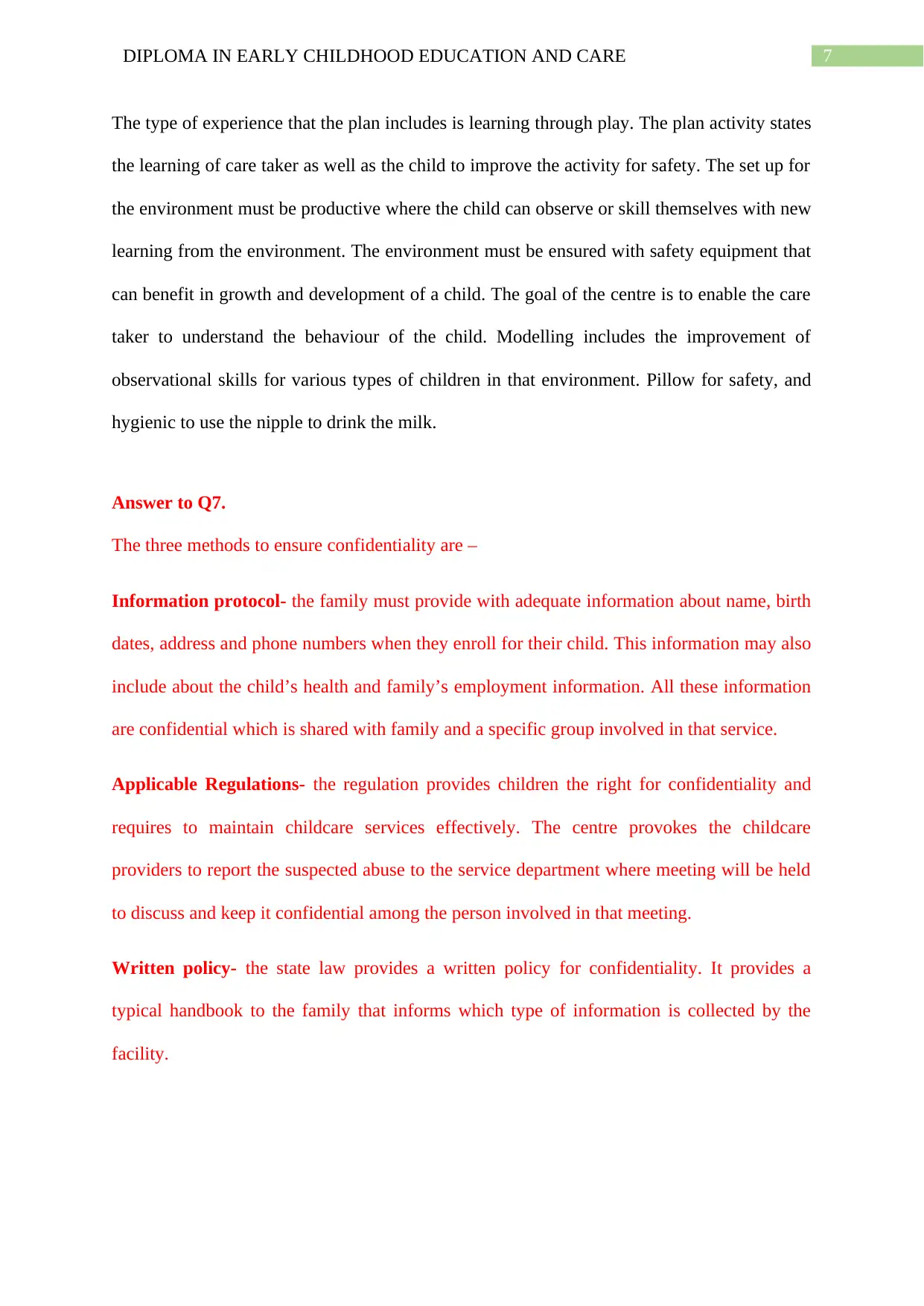
7DIPLOMA IN EARLY CHILDHOOD EDUCATION AND CARE
The type of experience that the plan includes is learning through play. The plan activity states
the learning of care taker as well as the child to improve the activity for safety. The set up for
the environment must be productive where the child can observe or skill themselves with new
learning from the environment. The environment must be ensured with safety equipment that
can benefit in growth and development of a child. The goal of the centre is to enable the care
taker to understand the behaviour of the child. Modelling includes the improvement of
observational skills for various types of children in that environment. Pillow for safety, and
hygienic to use the nipple to drink the milk.
Answer to Q7.
The three methods to ensure confidentiality are –
Information protocol- the family must provide with adequate information about name, birth
dates, address and phone numbers when they enroll for their child. This information may also
include about the child’s health and family’s employment information. All these information
are confidential which is shared with family and a specific group involved in that service.
Applicable Regulations- the regulation provides children the right for confidentiality and
requires to maintain childcare services effectively. The centre provokes the childcare
providers to report the suspected abuse to the service department where meeting will be held
to discuss and keep it confidential among the person involved in that meeting.
Written policy- the state law provides a written policy for confidentiality. It provides a
typical handbook to the family that informs which type of information is collected by the
facility.
The type of experience that the plan includes is learning through play. The plan activity states
the learning of care taker as well as the child to improve the activity for safety. The set up for
the environment must be productive where the child can observe or skill themselves with new
learning from the environment. The environment must be ensured with safety equipment that
can benefit in growth and development of a child. The goal of the centre is to enable the care
taker to understand the behaviour of the child. Modelling includes the improvement of
observational skills for various types of children in that environment. Pillow for safety, and
hygienic to use the nipple to drink the milk.
Answer to Q7.
The three methods to ensure confidentiality are –
Information protocol- the family must provide with adequate information about name, birth
dates, address and phone numbers when they enroll for their child. This information may also
include about the child’s health and family’s employment information. All these information
are confidential which is shared with family and a specific group involved in that service.
Applicable Regulations- the regulation provides children the right for confidentiality and
requires to maintain childcare services effectively. The centre provokes the childcare
providers to report the suspected abuse to the service department where meeting will be held
to discuss and keep it confidential among the person involved in that meeting.
Written policy- the state law provides a written policy for confidentiality. It provides a
typical handbook to the family that informs which type of information is collected by the
facility.
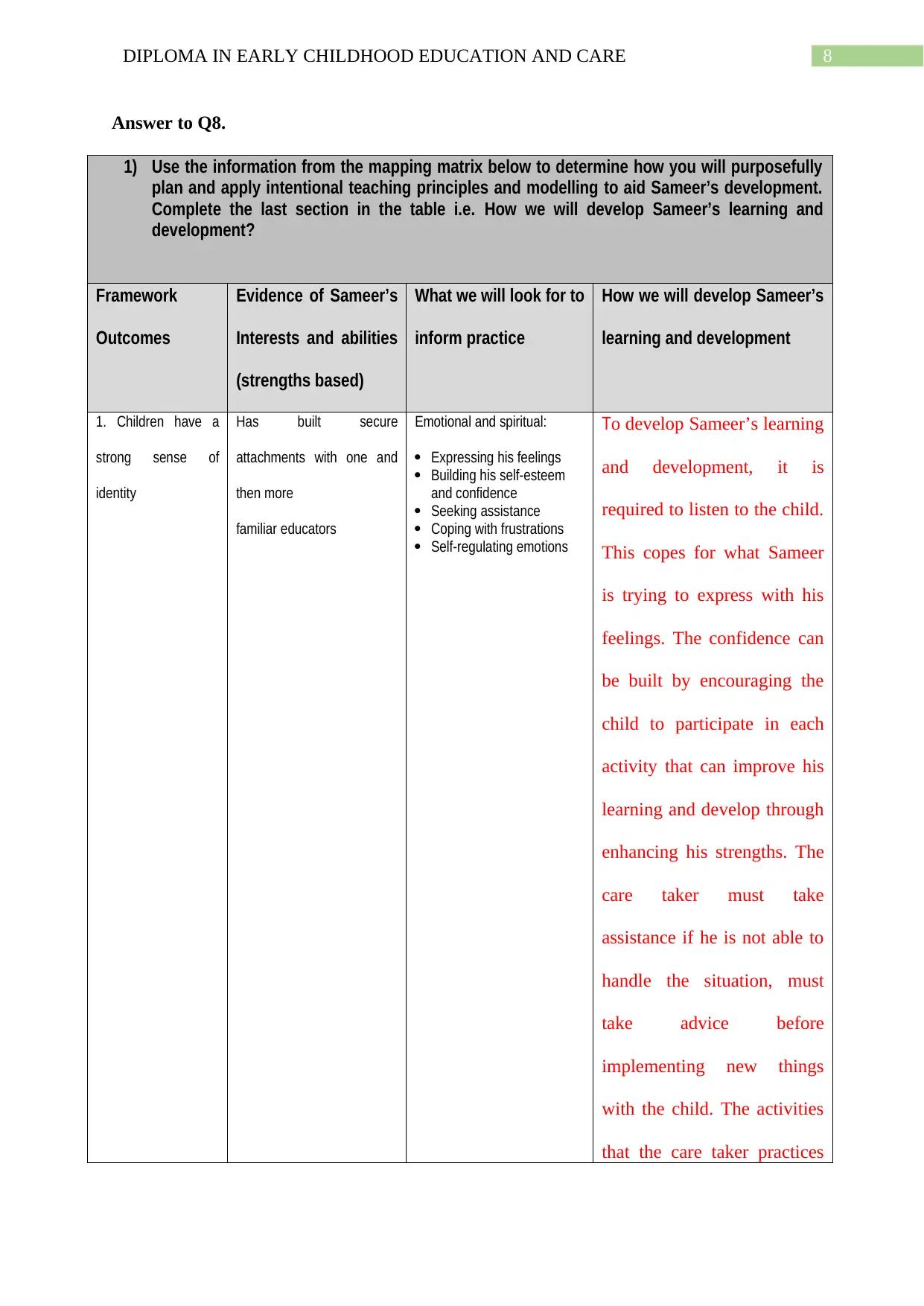
8DIPLOMA IN EARLY CHILDHOOD EDUCATION AND CARE
Answer to Q8.
1) Use the information from the mapping matrix below to determine how you will purposefully
plan and apply intentional teaching principles and modelling to aid Sameer’s development.
Complete the last section in the table i.e. How we will develop Sameer’s learning and
development?
Framework
Outcomes
Evidence of Sameer’s
Interests and abilities
(strengths based)
What we will look for to
inform practice
How we will develop Sameer’s
learning and development
1. Children have a
strong sense of
identity
Has built secure
attachments with one and
then more
familiar educators
Emotional and spiritual:
Expressing his feelings
Building his self-esteem
and confidence
Seeking assistance
Coping with frustrations
Self-regulating emotions
To develop Sameer’s learning
and development, it is
required to listen to the child.
This copes for what Sameer
is trying to express with his
feelings. The confidence can
be built by encouraging the
child to participate in each
activity that can improve his
learning and develop through
enhancing his strengths. The
care taker must take
assistance if he is not able to
handle the situation, must
take advice before
implementing new things
with the child. The activities
that the care taker practices
Answer to Q8.
1) Use the information from the mapping matrix below to determine how you will purposefully
plan and apply intentional teaching principles and modelling to aid Sameer’s development.
Complete the last section in the table i.e. How we will develop Sameer’s learning and
development?
Framework
Outcomes
Evidence of Sameer’s
Interests and abilities
(strengths based)
What we will look for to
inform practice
How we will develop Sameer’s
learning and development
1. Children have a
strong sense of
identity
Has built secure
attachments with one and
then more
familiar educators
Emotional and spiritual:
Expressing his feelings
Building his self-esteem
and confidence
Seeking assistance
Coping with frustrations
Self-regulating emotions
To develop Sameer’s learning
and development, it is
required to listen to the child.
This copes for what Sameer
is trying to express with his
feelings. The confidence can
be built by encouraging the
child to participate in each
activity that can improve his
learning and develop through
enhancing his strengths. The
care taker must take
assistance if he is not able to
handle the situation, must
take advice before
implementing new things
with the child. The activities
that the care taker practices
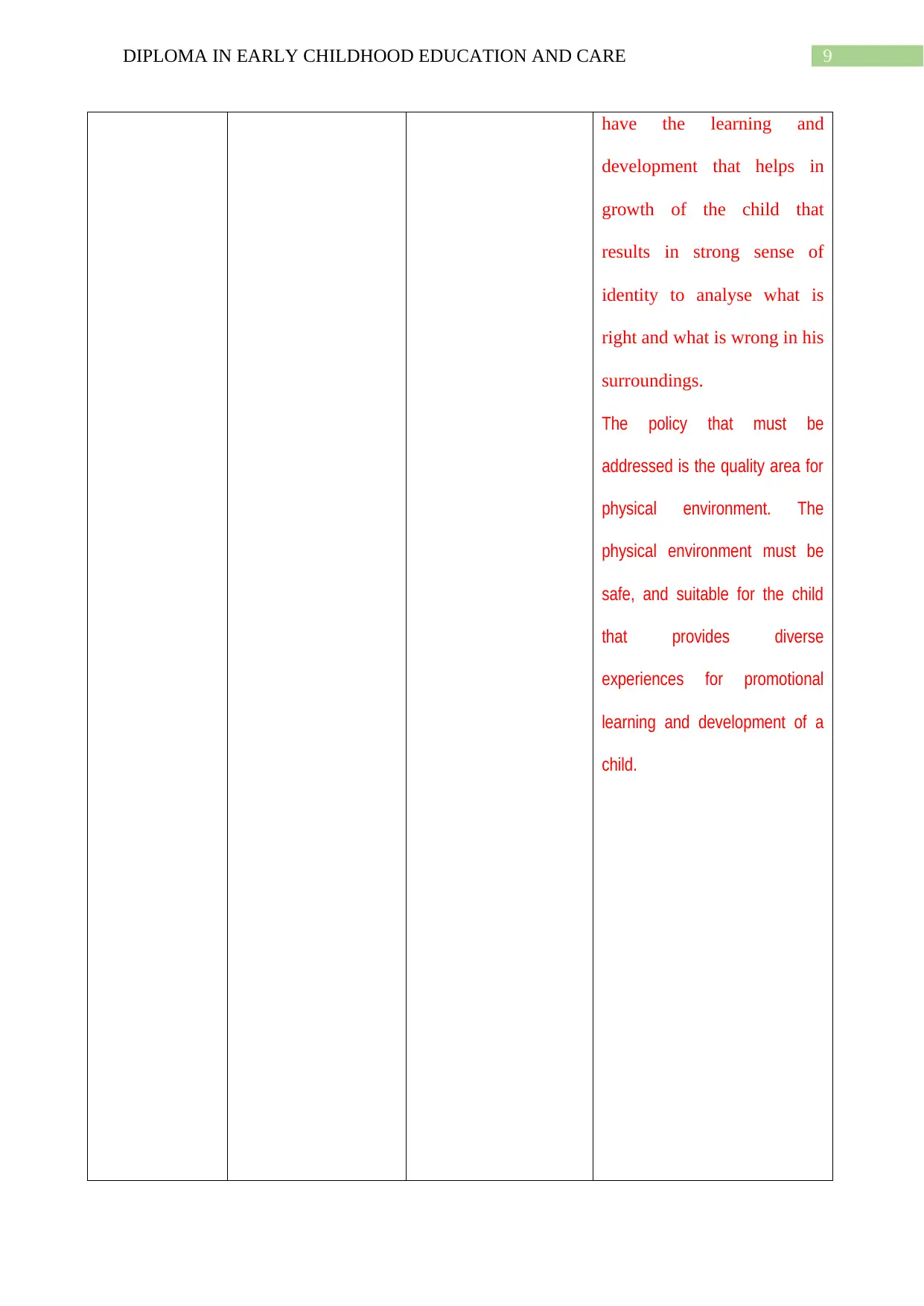
9DIPLOMA IN EARLY CHILDHOOD EDUCATION AND CARE
have the learning and
development that helps in
growth of the child that
results in strong sense of
identity to analyse what is
right and what is wrong in his
surroundings.
The policy that must be
addressed is the quality area for
physical environment. The
physical environment must be
safe, and suitable for the child
that provides diverse
experiences for promotional
learning and development of a
child.
have the learning and
development that helps in
growth of the child that
results in strong sense of
identity to analyse what is
right and what is wrong in his
surroundings.
The policy that must be
addressed is the quality area for
physical environment. The
physical environment must be
safe, and suitable for the child
that provides diverse
experiences for promotional
learning and development of a
child.
Secure Best Marks with AI Grader
Need help grading? Try our AI Grader for instant feedback on your assignments.
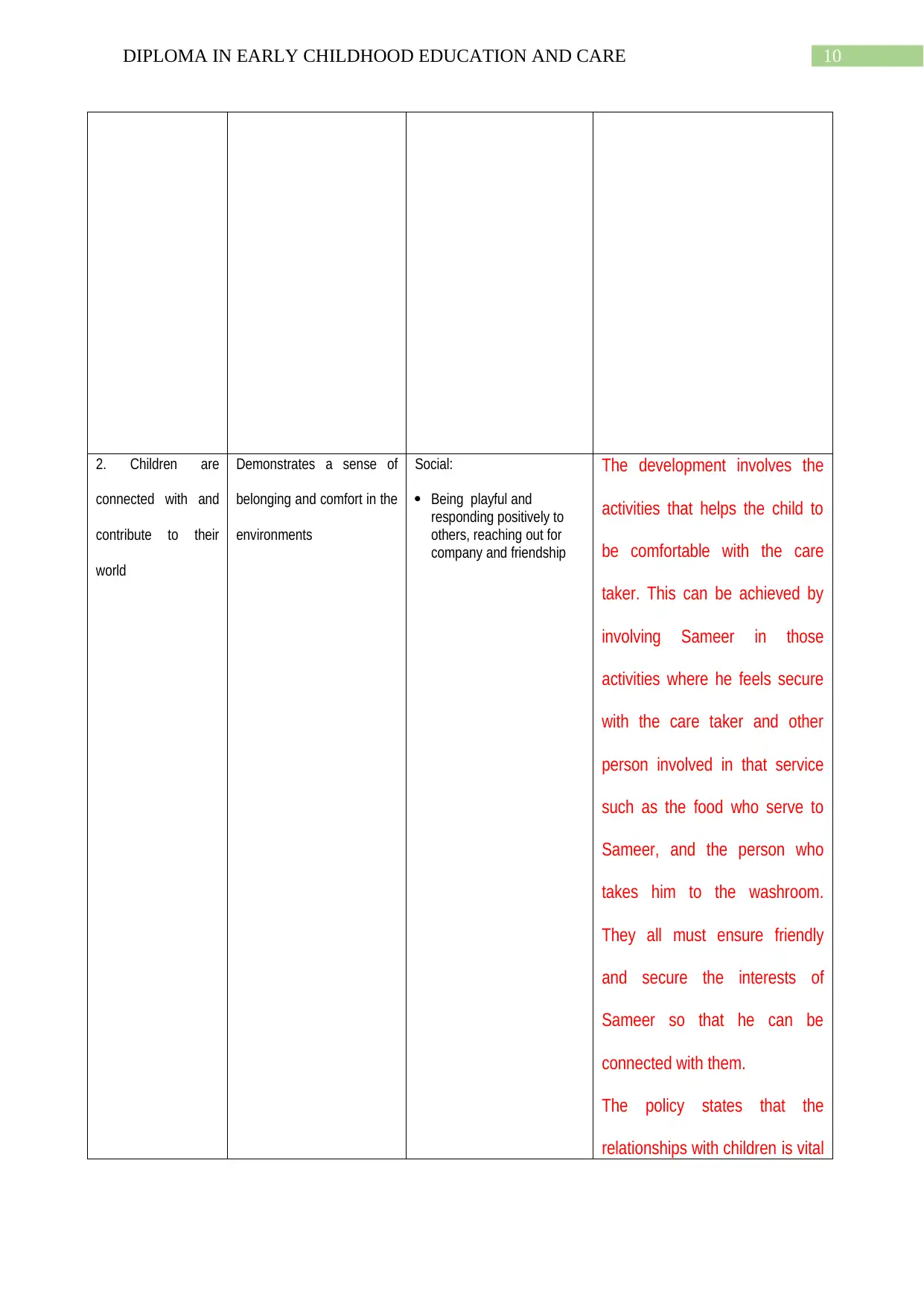
10DIPLOMA IN EARLY CHILDHOOD EDUCATION AND CARE
2. Children are
connected with and
contribute to their
world
Demonstrates a sense of
belonging and comfort in the
environments
Social:
Being playful and
responding positively to
others, reaching out for
company and friendship
The development involves the
activities that helps the child to
be comfortable with the care
taker. This can be achieved by
involving Sameer in those
activities where he feels secure
with the care taker and other
person involved in that service
such as the food who serve to
Sameer, and the person who
takes him to the washroom.
They all must ensure friendly
and secure the interests of
Sameer so that he can be
connected with them.
The policy states that the
relationships with children is vital
2. Children are
connected with and
contribute to their
world
Demonstrates a sense of
belonging and comfort in the
environments
Social:
Being playful and
responding positively to
others, reaching out for
company and friendship
The development involves the
activities that helps the child to
be comfortable with the care
taker. This can be achieved by
involving Sameer in those
activities where he feels secure
with the care taker and other
person involved in that service
such as the food who serve to
Sameer, and the person who
takes him to the washroom.
They all must ensure friendly
and secure the interests of
Sameer so that he can be
connected with them.
The policy states that the
relationships with children is vital
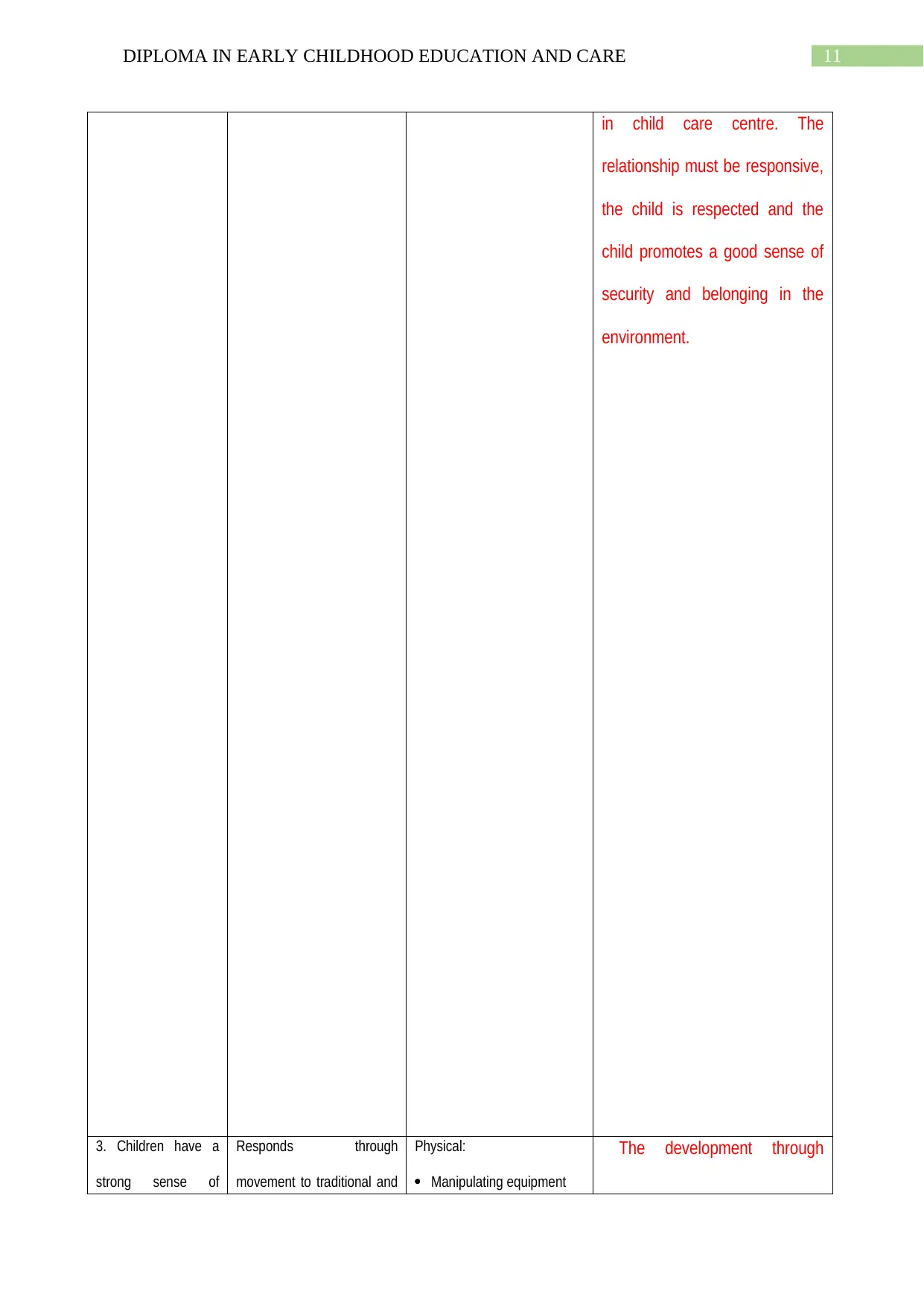
11DIPLOMA IN EARLY CHILDHOOD EDUCATION AND CARE
in child care centre. The
relationship must be responsive,
the child is respected and the
child promotes a good sense of
security and belonging in the
environment.
3. Children have a
strong sense of
Responds through
movement to traditional and
Physical:
Manipulating equipment
The development through
in child care centre. The
relationship must be responsive,
the child is respected and the
child promotes a good sense of
security and belonging in the
environment.
3. Children have a
strong sense of
Responds through
movement to traditional and
Physical:
Manipulating equipment
The development through
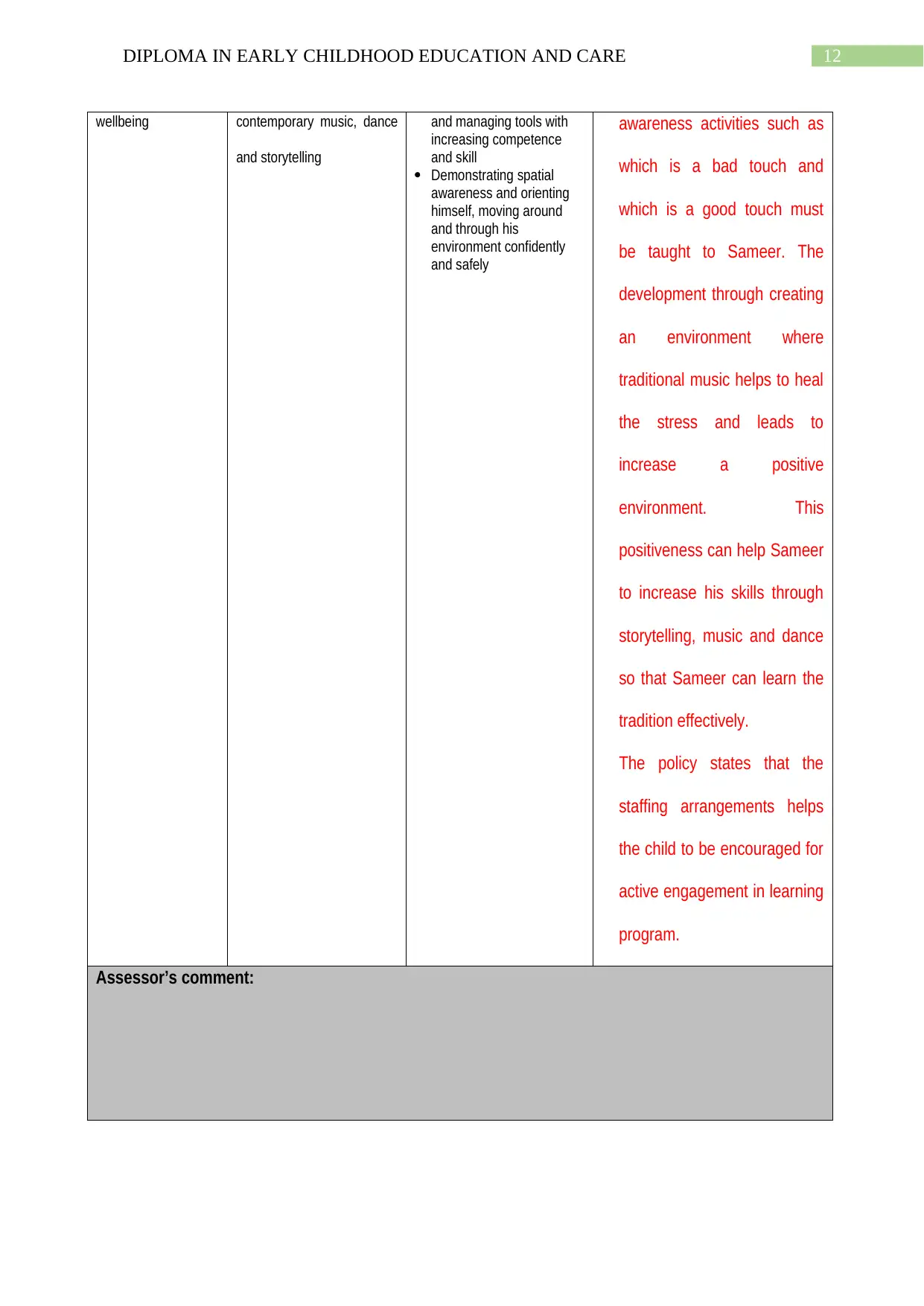
12DIPLOMA IN EARLY CHILDHOOD EDUCATION AND CARE
wellbeing contemporary music, dance
and storytelling
and managing tools with
increasing competence
and skill
Demonstrating spatial
awareness and orienting
himself, moving around
and through his
environment confidently
and safely
awareness activities such as
which is a bad touch and
which is a good touch must
be taught to Sameer. The
development through creating
an environment where
traditional music helps to heal
the stress and leads to
increase a positive
environment. This
positiveness can help Sameer
to increase his skills through
storytelling, music and dance
so that Sameer can learn the
tradition effectively.
The policy states that the
staffing arrangements helps
the child to be encouraged for
active engagement in learning
program.
Assessor’s comment:
wellbeing contemporary music, dance
and storytelling
and managing tools with
increasing competence
and skill
Demonstrating spatial
awareness and orienting
himself, moving around
and through his
environment confidently
and safely
awareness activities such as
which is a bad touch and
which is a good touch must
be taught to Sameer. The
development through creating
an environment where
traditional music helps to heal
the stress and leads to
increase a positive
environment. This
positiveness can help Sameer
to increase his skills through
storytelling, music and dance
so that Sameer can learn the
tradition effectively.
The policy states that the
staffing arrangements helps
the child to be encouraged for
active engagement in learning
program.
Assessor’s comment:
Paraphrase This Document
Need a fresh take? Get an instant paraphrase of this document with our AI Paraphraser
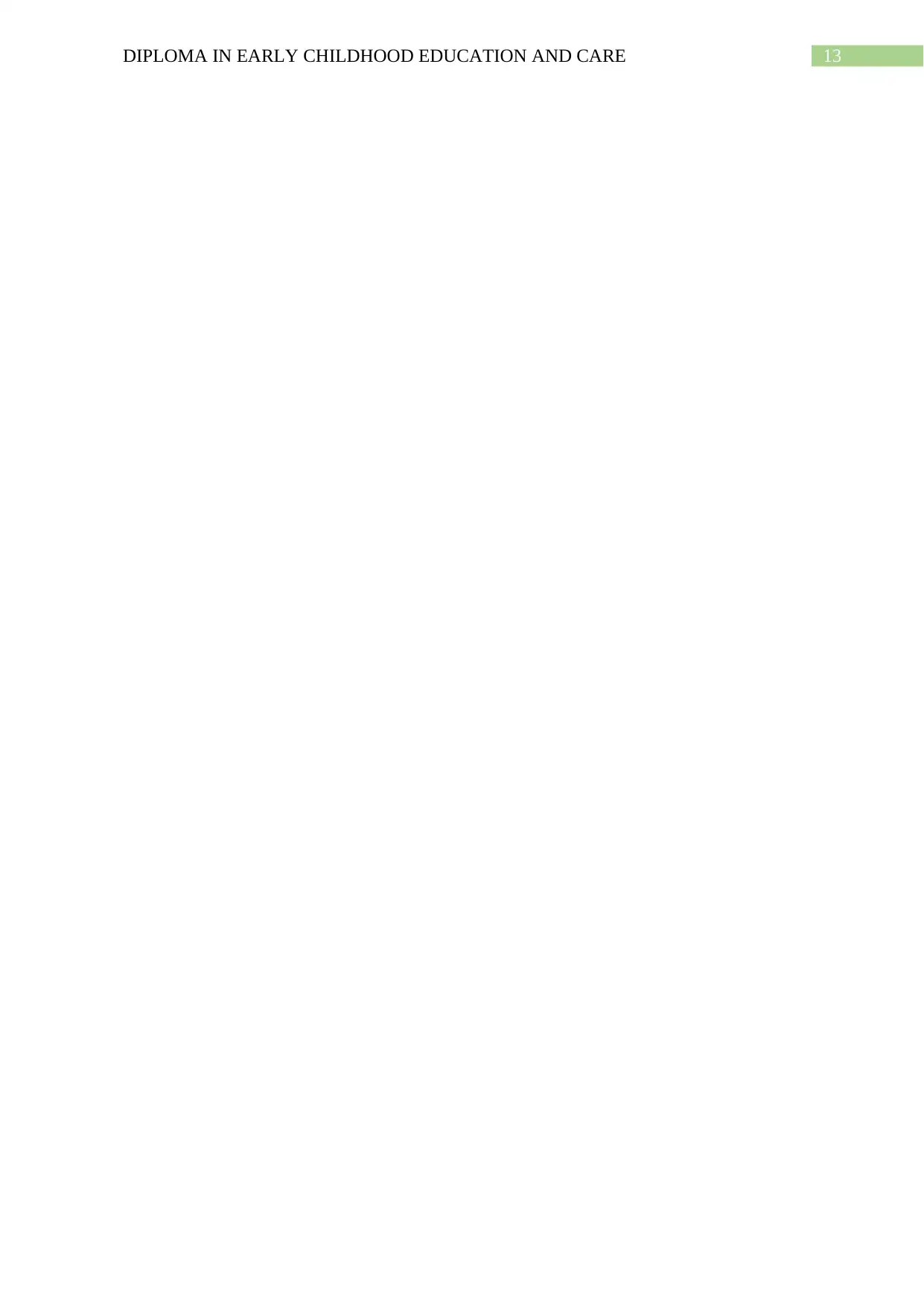
13DIPLOMA IN EARLY CHILDHOOD EDUCATION AND CARE
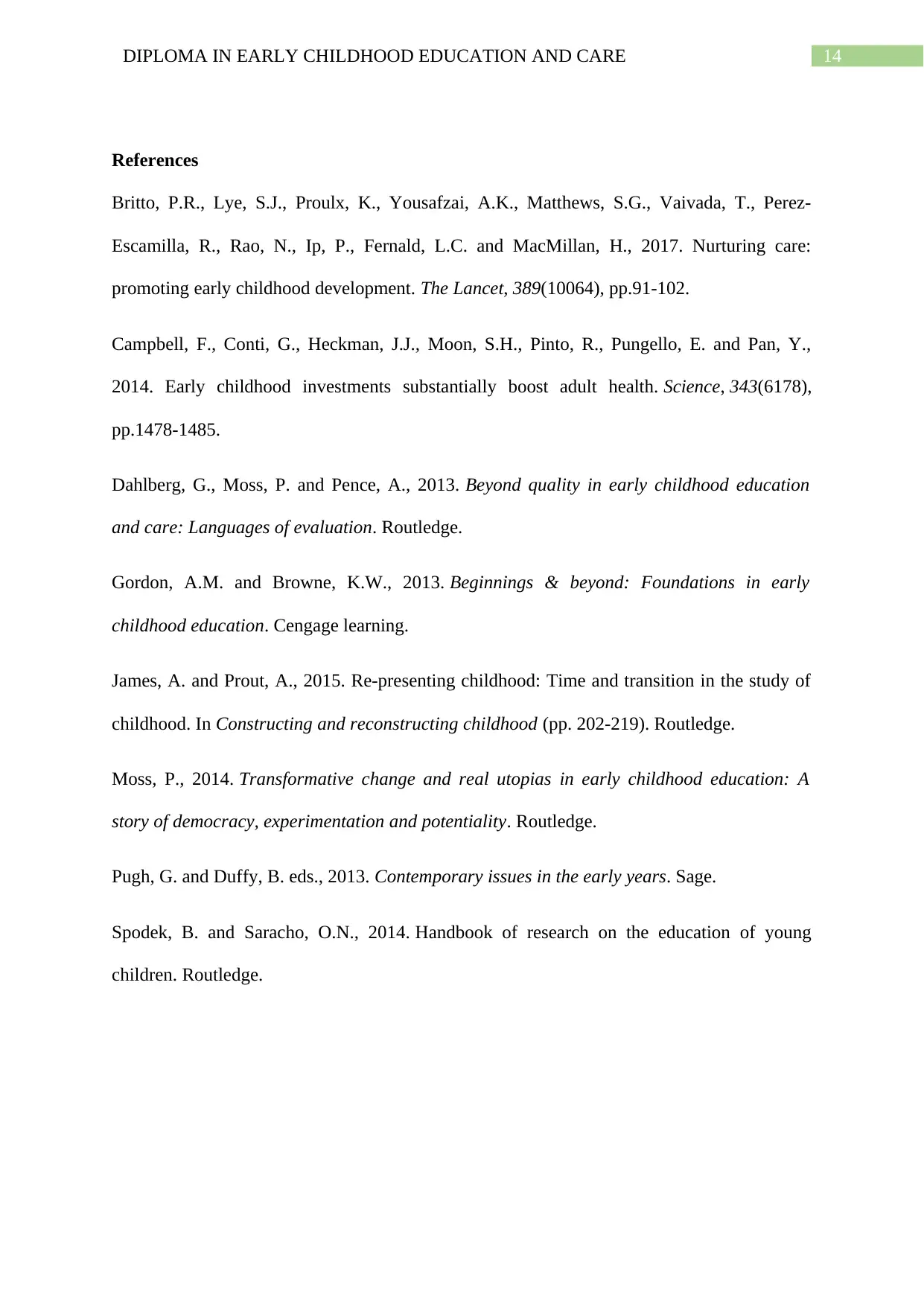
14DIPLOMA IN EARLY CHILDHOOD EDUCATION AND CARE
References
Britto, P.R., Lye, S.J., Proulx, K., Yousafzai, A.K., Matthews, S.G., Vaivada, T., Perez-
Escamilla, R., Rao, N., Ip, P., Fernald, L.C. and MacMillan, H., 2017. Nurturing care:
promoting early childhood development. The Lancet, 389(10064), pp.91-102.
Campbell, F., Conti, G., Heckman, J.J., Moon, S.H., Pinto, R., Pungello, E. and Pan, Y.,
2014. Early childhood investments substantially boost adult health. Science, 343(6178),
pp.1478-1485.
Dahlberg, G., Moss, P. and Pence, A., 2013. Beyond quality in early childhood education
and care: Languages of evaluation. Routledge.
Gordon, A.M. and Browne, K.W., 2013. Beginnings & beyond: Foundations in early
childhood education. Cengage learning.
James, A. and Prout, A., 2015. Re-presenting childhood: Time and transition in the study of
childhood. In Constructing and reconstructing childhood (pp. 202-219). Routledge.
Moss, P., 2014. Transformative change and real utopias in early childhood education: A
story of democracy, experimentation and potentiality. Routledge.
Pugh, G. and Duffy, B. eds., 2013. Contemporary issues in the early years. Sage.
Spodek, B. and Saracho, O.N., 2014. Handbook of research on the education of young
children. Routledge.
References
Britto, P.R., Lye, S.J., Proulx, K., Yousafzai, A.K., Matthews, S.G., Vaivada, T., Perez-
Escamilla, R., Rao, N., Ip, P., Fernald, L.C. and MacMillan, H., 2017. Nurturing care:
promoting early childhood development. The Lancet, 389(10064), pp.91-102.
Campbell, F., Conti, G., Heckman, J.J., Moon, S.H., Pinto, R., Pungello, E. and Pan, Y.,
2014. Early childhood investments substantially boost adult health. Science, 343(6178),
pp.1478-1485.
Dahlberg, G., Moss, P. and Pence, A., 2013. Beyond quality in early childhood education
and care: Languages of evaluation. Routledge.
Gordon, A.M. and Browne, K.W., 2013. Beginnings & beyond: Foundations in early
childhood education. Cengage learning.
James, A. and Prout, A., 2015. Re-presenting childhood: Time and transition in the study of
childhood. In Constructing and reconstructing childhood (pp. 202-219). Routledge.
Moss, P., 2014. Transformative change and real utopias in early childhood education: A
story of democracy, experimentation and potentiality. Routledge.
Pugh, G. and Duffy, B. eds., 2013. Contemporary issues in the early years. Sage.
Spodek, B. and Saracho, O.N., 2014. Handbook of research on the education of young
children. Routledge.
1 out of 15
Your All-in-One AI-Powered Toolkit for Academic Success.
+13062052269
info@desklib.com
Available 24*7 on WhatsApp / Email
![[object Object]](/_next/static/media/star-bottom.7253800d.svg)
Unlock your academic potential
© 2024 | Zucol Services PVT LTD | All rights reserved.


